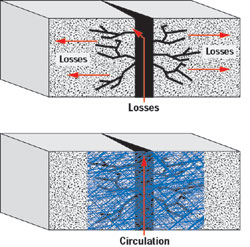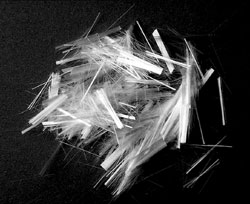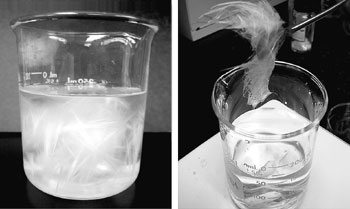Drilling & Completion Technology
Fibers in cement form network to cure lost circulation
Case histories from field applications in Indonesia prove new cement with added fibers created significant savings in problem wells
Effendhy and Hendri Junaidi, Caltex Pacific Indonesia; Raafat Abbas and Badar Zia Malik, Schlumberger
Encountering partial or complete lost circulation is not an uncommon occurrence in Caltex Pacific Indonesia’s (CPI) Duri field in the Central Sumatra basin of Indonesia. Lost-circulation rates can range from one barrel per hour to total losses. The ChevronTexaco affiliate utilized cement and various other conventional lost-circulation materials (LCM) in an attempt to cure the losses, with varying degrees of success. Schlumberger worked closely with the CPI Drilling Team to create a solution to cure the losses and successfully cement casing after blind drilling to total depth.
The following discussions describe: how the new cement works; how it was applied in Duri field; examples of significant cost savings; and applications of the advanced fiber cement use with coiled tubing.
HOW IT WORKS
The new-cement solution was CemNET, a patented, advanced cement that contains fibers to form an inert fibrous network across the loss zone, allowing circulation to be regained. The fibers are engineered to an optimal size for sealing loss zones and to convert a conventional cementing system to the lost-circulation system by mixing them with the slurry. The fibers, when added to the slurry and pumped downhole, form a mat-like bridge over the fractures and help create the required filter cake, Fig. 1. Use of these fibers has proven to be non-damaging to the formations.
 |
Fig. 1. Cement can be lost into natural fractures, fissures, vugs or highly porous zones. CemNET fiber cement acts to form a fibrous network across the loss zone, allowing circulation to be regained.
|
|
Advanced fiber cement to control losses can be used under all temperature conditions in all slurry densities and in most slurry formulations. Losses during cementing operations are eliminated, reducing need for expensive remedial squeeze operations. Designed cement tops are achieved with a reduction in cement fallback.
The inert fibers, Fig. 2, can be added to the cement continually, without affecting cement properties. This allows the fibers to be used only in the portion of the slurry designated to be pumped downhole where losses are expected to occur. Excess cement returns are reduced, resulting in lower disposal costs while providing immediate coverage of loss zones during cementing operations.
 |
Fig. 2. CemNET fibers are inert and require no special handling.
|
|
The fiber material is added to the slurry in the mixing tub. Because it is inert, it has no effect on thickening time and compressive strength development. It is compatible with all cementing additives. The fibers are also easy to disperse, resulting in no plugging of the slurry tub or cement line, Fig. 3. While it is recommended primarily to cure losses prior to cementing as in lost-circulation, cement plug applications, the new system also works well to cure losses during primary cementing.
 |
Fig. 3. As illustrated in this clear-fluid example (left), the fibers can be readily dispersed in water-base fluids such as cement. As shown in the demonstration (right), a network structure is formed allowing the cement to bridge off and resume circulation.
|
|
LOST CIRCULATION VIRTUALLY ELIMINATED
The Duri field is the world’s largest steam-flood project, with several billion barrels of original oil in place. The field produces an average 205,000 bpd from its 30,000-acre area. To continue this production rate, each day close to a million barrels of water is steam injected to heat the reservoirs and enhance oil recovery.
The field contains about 6,100 wells, including about 5,000 producers. The sand is unconsolidated. Oil is produced from structurally trapped multi-layered Miocene sandstone at depths between 200 and 900 ft. The reservoir is naturally faulted, increasing the risk of interconnecting steam to the wellbore and the surface, as well as increasing well-control risks. Steam injection is used to reduce the oil’s viscosity, which is 16° to 20°API in natural reservoir temperatures. The wells are produced with artificial lift equipment.
In the Duri well in which the first CemNET job was pumped, total lost circulation was experienced while CPI was drilling through a 531-ft formation. An unsuccessful attempt was made to cure the loss by pumping 80 bbl of mud with 30 lb/bbl lost-circulation material. After waiting for the LCM to settle, an attempt was made to continue drilling; however, no mud returns were seen at surface.
CPI made the decision to continue drilling according to its standard operating procedure. Subsequently, the operator drilled blind to total depth at 562 ft, at which point Hi-Vis was spotted for logging purposes. A total of 44 bbl of 14-ppg cement slurry with fibers was pumped. Surface returns occurred after only 30 bbl of the slurry were pumped. Circulation was established after the cement was drilled out.
CPI now uses the new cement on all jobs in which a lost-circulation situation is encountered while drilling. CPI’s procedure is to perform blind drilling to TD, set CemNET plugs, drill out the cement and gain mud circulation.
More than 100 lost-circulation plugs and primary cementing jobs have been completed in Duri with advanced fiber-cement technology, which continues to post a success rate of about 90%.
SIGNIFICANT SAVINGS
Use of the new system has generated important savings, compared with other traditional cementing operations. The savings are a result of the likelihood that only one cement job is generally required. Other methods of curing lost circulation may be unsuccessful, requiring additional attempts to halt losses. Such other applications previously used include: Bentonite Diesel plugs; Bentonite/cement diesel plugs; nut-plug LCM; rice husk; and sized calcium carbonate pills. Several examples illustrate a minimum savings of 21.5 hr of rig time, translating into significant per-well savings.
One example that compares the advanced, fiber-cement system with a regular cement plug resulted in CemNET eliminating a second potential cement job, resulting in rig time savings of 21.5 hr. Although treatment costs are slightly higher, compared with regular cementing services, reduced rig time from elimination of subsequent attempts to cure a lost-circulation problem results in significant overall savings.
Similar cost-saving scenarios result when comparing cement vs. Thixotropic Plug, and CemNET vs. BDOC (Bentonite Diesel Oil Cement). The cost savings result mainly from the likelihood of curing the lost circulation in one cement plug vs. previous multiple attempts using conventional methods.
ADVANCED FIBER CEMENT AND COILED TUBING
Coiled tubing (CT) cementing applications utilizing advanced fiber cement began in 2002 in the Bekasap, Minas and Sebanga fields operated by CPI. The applications are mainly to shut off perforations due to high watercut in Bekasap and Sebanga and for steam profile distribution in Minas.
The slurry was conveyed via a 2-in. coiled tubing with a 1.68-in. ID. The average treating pressure was 500 psi, which is considered low, and significantly below CT pressure limits. The first advanced-fiber cement slurry pumped through CT was performed in Minas to squeeze off 300 ft of perforated interval in an injector well. This was performed due to severe losses during injectivity tests during a previous workover operation (5.75 bpm with pressure at 75 psi).
The squeeze pressure was achieved following the first 10 bbl of slurry placed into the formation, indicating that circulation was regained. Pressure tests were conducted at the squeezed interval after the job and held at an injection pressure of 200 psi, plus hydrostatic pressure of 1,200 psi, for 10 min. A total of 10 bbl of 15.8-ppg CemNET lead slurry, followed by regular tail slurry, was pumped.
Another CT job was performed in Minas on a producing well with 99% watercut from the existing intervals. These intervals were to be shut off and new, perforated intervals opened. This required squeezing off five existing perforated intervals and reopening those zones that still had significant production potential.
A workover rig installed 1,600 ft of 4-1/2-in. open-ended tubing and performed an injection test, which showed a lost circulation problem in the well, i.e., 70-psi circulating pressure @ 5.75 bpm. Schlumberger pumped advanced fiber cement slurry through 6,000 ft of 2-in. (1.68-in. ID) CT, including spooled CT. The fibers were mixed on the fly and spread evenly to avoid plugging the pump and the CT.
Annulus pressure increased when the slurry exited the end of the CT, indicating that the cement system eliminated further losses. Annulus pressure was maintained at 300 psi. After waiting on cement for 6 hr, a pressure test was performed and held at 200 psi for 10 min, confirming that the cement slurry shut off the perforated intervals.
The advanced fiber cementing system is now part of normal cementing practices in Duri field. This technology is assisting the drilling team to drill and complete wells in time, in turn helping CPI to meet its field development/ production plans. 
THE AUTHORS
|
| |
Mr. Effendhy joined PT Caltex Pacific Indonesia, a subsidiary of ChevronTexaco, in May 1998, as a drilling representative working in Duri field. In 2001, he moved into operations, where his responsibilities include developing drilling programs, AFEs and special projects. He graduated from Bandung Institute of Technology (ITB) Indonesia, in April 1998 with a degree in petroleum engineering.
|
|
Hendri Junaidi joined PT Caltex Pacific Indonesia in June 1998, as a drilling representative working in Duri field. In 2000, he moved into operations, where his responsibilities include monitoring drilling operations. He graduated from Bandung Institute of Technology (ITB) Indonesia, in April 1998, with a degree in petroleum engineering.
|
|
Raafat Abbas is the global product champion for Schlumberger CemNET and WELLCLEAN II Engineering Solution. His main responsibilities include training, technical support and marketing of these cement technologies both internally and externally. He previously held various operations and technical positions in the Middle East, ranging from field engineer to cementing technical engineer. He holds a BS degree in chemical engineering from California State Polytechnic University.
|
| |
Badar Zia Malik is the technical engineering manager for Schlumberger located in Duri, Indonesia, where he is responsible for all engineering/technical support for operations. Prior to this assignment, he worked in various operations/technical positions within the Schlumberger group in the Middle East, East Europe and Far East. He holds a bachelor’s degree in mechanical engineering from the University of Engineering and Technology Lahore and has authored and co-authored publications in the area of well stimulation, coiled tubing and cementing. He is working as marketing and sales manager for Schlumberger Scandinavia Operations.
|
|





